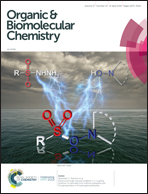A far-red to NIR emitting ultra-sensitive probe for the detection of endogenous HOCl in zebrafish and the RAW 264.7 cell line†
Abstract
Fluorescence imaging is a dynamic tool for monitoring the functions of biomolecules in living systems. Probes with emission in the far-red to near-infrared range have been found to demonstrate great application prospects in bioimaging due to their deep tissue penetration, low background fluorescence, minimum photodamage to the tissue and high sensitivity. The present study aimed to construct a far-red to near-infrared emitting probe (PI) bearing dicyanoisophorone coupled with a phenothiazine moiety. The probe exhibits an instant response towards HOCl with a colour change from red to yellow with a 100 fold fluorescence enhancement at 620 nm with a low detection limit (42 nM). The electron-rich sulfur atom can be oxidised by HOCl; this endows the probe with distinct selectivity over other anions as well as other reactive oxygen species. The probe demonstrates great cell permeability with low toxicity to the cell. Therefore, the probe can be effectively applied in biological systems to monitor the endogenous level of HOCl produced by PMA in living systems and in the fluorescence imaging of endogenous HOCl in zebrafish and the RAW 264.7 cell line.



 Please wait while we load your content...
Please wait while we load your content...